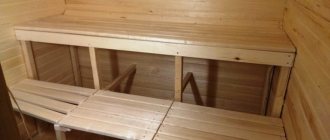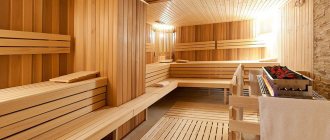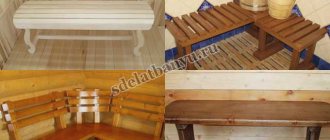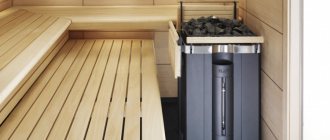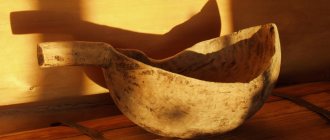If not everyone can build a bathhouse with their own hands, then anyone can cope with making the decor. Do you want to make your bathhouse original and cozy? We suggest paying attention to such a simple but necessary item as a bath hanger.
Room interior
There is no more suitable place where you can simultaneously relax after a busy work week, imbue yourself with harmony, and cleanse your body than a sauna or bathhouse, which is closer in spirit to the Russian spirit.
For many, visiting it is a tradition that is supported by every generation, and is often instilled in families from early childhood, so it is not surprising that our compatriots want to have their own bathhouse in the backyard.
Great place to relax
The environment inside should give harmony and tranquility. This atmosphere is achieved by the combination of all parts of the interior. You should not think that the type of Russian baths is a standard steam room with a stove and the same type of shelves. A designer interior is always distinguished by original details and decor; only by implementing an individual project can you get a stylish room for couples and relaxation.
Stylish room in oriental style with your own hands
Quality, thoughtful finishing and accompanying accessories are three pillars of internal content that will never cause you any inconvenience. For information on how to equip the interior, I will tell you today. These ideas can be used both at home, for your own needs, and for business.
How to make wooden chairs and stools with your own hands for a bath?
DIY fabric crafts - interesting master classes, photo ideas and tips
Components for the future stool: four boards (to be used for the seat), two bars that will strengthen the boards, four crossbars and four legs.
Sequencing
- First you need to install four boards on a flat surface so that they are one centimeter apart;
- Then you should secure the boards with bars;
- It is necessary to install the legs into the grooves of the bars;
- Next, insert and fix the crossbars;
- The finished stool must be sanded and coated with a protective compound.
What types of benches and benches (chairs) are there?
There are three types of benches in the bathhouse: folding, stationary (attached to the wall) and portable. Each of them is unique and has its own pros and cons.
- Folding benches and benches are very simple and therefore compact. Even an inexperienced person can easily create them. They don't require much time or effort;
- A feature of stationary benches and benches is that they are firmly attached to the wall. They cannot be moved. But such benches are much more comfortable to sit on, because they usually have a very good back;
- It is worth highlighting portable benches and benches for the bath, which are characterized by mobility, because they can be moved from one place to another without much effort.
Deciding on the material
Wall hanger in the hallway: DIY crafts and unusual ideas
The choice of material is extremely important, since the result will significantly depend on it. Plastic is a material that is practically not used in baths. Firstly, the reason is personal hostility. The bathhouse, in essence, is almost a vacation in nature (at high temperatures), and you don’t really want to see ordinary things in such situations. Secondly, safety. Nowadays, many manufacturers want to make the most money, so they use cheap materials. If you come across low quality plastic, then most likely this material will begin to release toxic substances when heated. Thirdly, physical properties. Products made from it cannot withstand high temperatures, so they quickly deform in steam rooms and dressing rooms.
But then a completely logical question arises: what should you pay attention to if neither plastic nor metal can be used. The most suitable option is wooden hangers
They were the ones that were used in Ancient Rus'. Almost everything in the bathhouse was made only of wood.
Wood is a natural and cheap material and is not afraid of corrosion. The main advantage is diversity. The problem of choice should not arise.
Style
Let's start with style. This time we would like to limit theorizing on this topic as much as possible. Therefore, we will limit ourselves to introducing two poles - simplicity and ornateness, and between them let there be many intermediate options, including various attempts to imitate different eras or countries.
So, the more traditional , the wider the possibilities - hangers of any degree of ornateness will suit you, and of the simplest ones, only those that combine exaggerated rigor of geometry with metal or glass elements are not suitable.
Original homemade hangers in the bathhouse shown in the previous photo
The more modern your bathhouse is, the better it is to opt for relatively simple interior elements. Of course, we are not talking about high-tech now, but simply about a comfortable bathhouse in which modern materials are used, everything is functional and there are not many references to tradition .
What do we mean by comparative simplicity? The presence of some decorative elements , but subordinate to functionality and not very attractive.
Let us explain: the more original your hanger is, the more demanding it will become to its surroundings . You need to understand the principles of stylistic unity - if you put Khokhloma on the table, then several other interior items should play with similar patterns, and the entire interior as a whole should be designed in the Russian ethno-style. A single out-of-the-ordinary object will irritate rather than please the eye.
Making a wooden shelf for a hanger in a bathhouse
DIY photo album: design ideas and tips for beginners
To make a fairly wide part, for example, a shelf 300 mm deep, it is advisable to purchase glued furniture panels. This will greatly simplify its production.
In addition, for the work you will need wood screws, furniture plugs made of wood, furniture dowels 10 × 30 mm, a square, a tape measure 3 m long, a ruler, abrasive sandpaper, PVA glue for wood, stain if you plan to change the color of the wood, moisture-resistant acrylic varnish water-based for wood, a hand-held circular saw and an electric drill with a set of drills, as well as a wood saw, a screwdriver and an electric jigsaw.
The sides, located at the edges of the shelf, act as brackets and give it strength. As a result, it will be able to easily withstand the weight of things and objects placed on it.
When assembling the shelf, it is necessary to dock it with two sidewalls, which act as brackets. First you need to make the sidewalls: cut out the blanks along the drawn contour with an electric jigsaw and treat them with abrasive sandpaper. After this, you need to mark the centers of the holes for the wooden dowels, maintaining dimensions of 50 and 200 mm on the side edge, and 25 and 130 mm on the end part, which is adjacent to the vertical stand.
The same should be done for the shelf, marking the centers of the holes on it in the right places. After this, they need to be drilled out on all parts. You need to install 4 dowels in the shelf, having previously covered them with PVA glue.
Using dowels, you need to connect the sidewalls and the shelf, leading them into the provided holes. In this case, the protruding parts of all dowels must be treated with PVA glue.
Since the sidewalls will bear the entire load from the items stored on the shelf, they need to be properly attached to the outermost vertical boards of the sheathing.
To do this, you can use wooden furniture dowels as an addition to self-tapping screws.
Holes for dowels are already drilled at the ends of the sidewalls. All that remains is to coat them with glue and drive them in. After this, you need to drill the same holes in the outer vertical boards of the sheathing, and then connect them together.
In this case, it is extremely important to make sure that the joining of the previously assembled shelf was done correctly: it should lie on the longitudinal edge of the hook holder with its lower edge. The shelf is attached to the sheathing using self-tapping screws
First, two self-tapping screws are screwed into each side panel from the back of the vertical boards. Then fix the shelf on the upper edge of the hook holder using one or two self-tapping screws
The shelf is attached to the sheathing using self-tapping screws. First, two self-tapping screws are screwed into each side panel from the back of the vertical boards. Then fix the shelf on the upper edge of the hook holder using one or two self-tapping screws.
What do you need for work?
Since the hanger is made of wood, pre-planed hardwood boards should be used as the main material. The number and thickness of the boards will depend on the type of hanger and the pattern according to which it will be made.
What tools may be required for the job?
The work will also require the following tools and materials:
- dowels (chops) for furniture assembly;
- set of self-tapping screws;
- special wood plugs;
- glue;
- stain and acrylic varnish;
- electric drill;
- set of drills;
- hacksaw or circular saw (if available);
- jigsaw;
- Phillips screwdriver or screwdriver;
- hammer;
- ruler;
- roulette;
- sandpaper with varying degrees of abrasiveness;
- square
Moisture-resistant wood glue
You will also need a pencil or marker to mark the wood where you want to cut or drill. When everything you need is at hand, you can start working.
Choosing material for bath hangers
All attributes for a bathhouse are selected taking into account the characteristics of use. The hanger is no exception. The action of steam, high humidity, and significant temperature changes will quickly render a product made from unsuitable material unusable. In addition, the device must match the style of the room.
The material is selected taking into account the following parameters:
- high resistance to rot and mold;
- low thermal conductivity;
- resistance to moisture and steam.
Cost is also taken into account when choosing. You need a little wood, but it doesn’t make sense to use an abashi product in a simple larch bathhouse.
Coniferous wood
When choosing wood for hangers, preference is given to coniferous wood. It contains more resinous substances and, accordingly, is much more resistant to moisture. Pine, spruce, larch, cedar - any tree is ideal for making bath fixtures.
It is worth considering one feature: at high temperatures, the resin is released much more intensely than at normal temperatures. Therefore, pine and spruce hangers are not suitable for pairs. But cedar is perfect: the material includes special resinous substances.
Hardwood
Hardwood is used only if it meets the above criteria. For example, a pear or apple tree is not suitable, since wood that is soft and prone to swelling will not last long in a bathhouse. Aspen, birch, and linden are much more suitable, that is, the wood that is used to decorate the steam room and dressing room.
In this case, the characteristics of the wood are taken into account. So, linden is prone to mold, products made from it need to be treated with antiseptics. Aspen, if chosen correctly, only hardens from water and steam and does not need treatment.
Important! It is better to choose wood for the steam room that does not get very hot: linden and aspen. This prevents possible burns
Exotic wood
Bath hangers can also be made from exotic wood, such as abashi. The wood is resistant to rotting, water and even cracking, so it can be used in a sauna, steam room, and guest room. In addition, it has a beautiful pattern. However, like any exotic wood, it costs a lot.
Bath hanger made of knots
This is a simple design from one high-quality processed board and Y-shaped knots, which is assembled as follows:
- Select knots 1.5-2 cm thick. Let the wood dry, remove the bark from it, and clean the surfaces.
- First sharpen the end of the branch on which things will hang with a rasp and then sand it with sandpaper.
- To attach the knots, a board 40 mm thick is required. To make the board look beautiful, give it an original look. It is better to draw the shape of the support board first on a blank sheet of paper; the sketch should not be larger than the size of the board. Cut out a board layout from paper, attach it to it and trace it with a pencil. Treat the workpiece with a carpenter's tool and sand it with sandpaper.
- The knots on the board should be attached to dowels, so mark the position of the holes for the fasteners on the hanger.
- Make holes in the board and knots for dowels.
- Press dowels 1.5-2 cm into the holes of the knots; they should protrude 2 cm from the knots. Secure the knots to the board using dowels and PVA glue.
- Coat the hanger with a water-repellent compound.
Hanger made of wooden chocks for a bathhouse
Such a hanger is made from oak or maple chocks with uncut branches. To make such an unusual hanger, it is advisable to find a ready-made photo of a hanger in a bathhouse with your own hands and use the picture as a visual aid. Making a hanger from chocks:
- Choose samples with branches that are similar in shape and size to hanger hooks.
- Using an axe, cut the log in half so that the part with the branches remains. The resulting pieces should be no larger than 15x15 cm in size and knots with a diameter of 3-4 cm. Meter-long logs will not work.
- Sand the side of the chip with a plane.
- Sand the surface of the workpiece to give it a noble appearance.
- Make several of these hangers; they can be installed in unlimited quantities.
- Attach the hangers directly to the wall of the bathhouse using self-tapping screws.
Construction device
The shelves in the bathhouse are often called a bench in the common people. They are called that for a reason, since the entire structure is a flooring of benches that differ in level. Any shelf design for a bathhouse consists of two fundamental parts:
- The frame is necessary for the correct fastening of boards for permanent decking; it is also used to support a collapsible decking system. To build it, support posts are required; they can be compared to the legs of a bench.
The racks are connected by large boards that serve as jumpers necessary for the correct, level position of the shelf. Very rarely they are built according to the stringer principle, which serves as the basis for installing a flight of stairs. If Finnish technology is used, then when creating the frame there is no need to install supports, since the entire structure can be attached to the walls of the steam room.
The flooring is constructed from thin planks, which are first made absolutely smooth by sanding. Their thickness is about 2 cm. It is recommended to choose linden or aspen as the material for production. The boards are stuffed with a small gap. The flooring is attached to the frame or to the ladders, which must be separately knocked together and installed on the floor.
If the flooring is not secured, it can be taken out into the fresh air for ventilation in the summer. Together with the flooring, you can build backrests for seats, devices for raising legs to a certain height, and sides of shelves.
The steam room is usually built in small sizes, since the smaller the room, the lower the heating costs and the faster it warms up to the required temperature for steaming. To set up a steam room well, you need simple, even furniture. Ladders for climbing shelves are often large and have 2-3 steps.
If the bath area is too small, it may not be possible to create a bottom shelf of a standard shape and size. In this case, you can build a triangular shelf. You should get an isosceles triangle, one of the legs of which needs to be attached to the wall, and the second is adjacent to the adjacent shelf.
Bath shelves are always multi-stage. This is due to the simplest laws of physics. The hot air gradually rises upward, part of it goes outside through the ventilation, and the rest is reflected from the pre-installed overhead system, so it returns and remains at the top of the building. Gradually, the upper part of the room becomes much warmer than the lower part, so everyone has the opportunity to choose the optimal temperature for themselves by sitting on a specific shelf.
When constructing shelves, you should adhere to the traditional configuration, designed according to the principle of a ladder. With each vape, a person will be able to independently choose a strong steam or a fairly moderate atmosphere
In addition to this aspect, the bottom shelf is of particular importance. With its help, the bathhouse attendant can easily climb to higher tiers or use it as a podium for a convenient approach to the person receiving the procedure
In the steam room you can install shelves on both two and three sides. A large number of them will allow you to invite more guests to the bathhouse. When planning the structure, it is necessary to take into account the possibility of free movement. Staying in the steam room should not cause traumatic consequences.
Another video about how to make shelves for a bathhouse.
Corner shelves
Shelves in a bathhouse can be not only horizontal, but also made with two perpendicular sides. Corner shelves are often constructed by stitching together several blocks of boards. Steam rooms look elegant where the shelves are lined up in tiers on one side, and the corner shelf is located only in the bottom row, smoothly framing the nearby wall, smoothing out the corners.
For a large steam room, you can provide for the arrangement of tiers of shelves parallel to each other, and between them place one lower shelf, which will be fastened to the adjacent ones, serving as a corner shelf for each. You can use it as a bench, stand, or put various objects on it. It will be located opposite the entrance.
The choice of materials for the interior decoration of the bath
When choosing building materials, it is important that they meet the following requirements:
- Resistant to high temperatures and sudden changes.
- Moisture resistance.
- Safety - a person should not have an allergic reaction or burns upon contact with the material.
- Environmental safety – absence of toxic substances.
- Hygienic - the material should be easy to maintain and clean.
- Long service life.
- High strength and reliability.
- Attractive appearance.
Steam room finishing
The best material for cladding a steam room is wood, but it is better to give preference to hardwood. The thing is that these types of wood do not heat up, you won’t get burned on them, there is no release of resins, and when ventilated, the material dries quickly, making the formation of fungus impossible.
Types of wood for finishing the steam room:
- Aspen is a classic option for the northern regions of Russia, since the material is low in cost, due to its high strength it is difficult to split, and in addition, the wood has bactericidal properties.
- Linden is an attractive material with a stable color and low heat capacity. Due to this, the tree quickly gains temperature and is safe to touch. Linden also creates a pleasant atmosphere due to its special aroma and has a low price.
- Abash is a material that is just becoming popular, since it is wood from the African tropics and we still don’t know enough about it. It is best to make shelves from abasha that are resistant to steam and high temperatures, since they hardly heat up.
- Alder is an attractive visually and tactile wood material that is resistant to steam room conditions. Easy to maintain and clean, low cost.
It must be remembered that wood should never be painted or varnished, since under the influence of high temperatures the coating will release harmful chemicals and odors. When finishing, nails and screws must be carefully hidden, as they heat up and can cause burns. Experts also recommend filling the lining vertically, because the water drains much faster this way.
Waterproof skirting boards will help protect the joint between the walls and the floor. For finishing the floor, it is best to use larch or tiles - the latter option is more preferable, as it is resistant to fungus and is easy to clean. If the tile seems cold, a wooden grate is placed on it, which can be easily removed if necessary.
Finishing the dressing room and sink
It is better not to use wood for lining the sink; preference is given to tiles, since in the shower there is constant contact with water. Ceramic tiles do not rot, they are easy to care for, and for an attractive appearance, you can choose special stylish tiles that imitate natural wood.
As for the dressing room, it is a warm and cozy place, but there are no high temperatures here, so it is allowed to use coniferous wood with a pleasant and healthy aroma.
Among the popular types of wood for finishing the dressing room are:
- Pine is an attractive and durable material that has a long service life and is the most popular. During use, the wood may change color, becoming a little redder. Also popular is Scandinavian pine, which has a pink tint and annual rings that create a decorative pattern on the walls.
- Spruce has a homogeneous structure; when dried, it remains solid and does not crack. The color scheme is slightly lighter than pine.
- Fir is a tree that has properties similar to spruce, but practically does not emit resin.
Form
By design, all hangers can be divided first into the following:
- wall-mounted (have no other support other than walls);
- floor-mounted (may not be attached to walls).
In turn, wall and floor ones can be located along one of the walls, or located in the corner.
Wall mounted
The most minimalistic version of a hanger is a board, on one side of which hooks are attached (these can be wooden sticks, forks of branches, door handles, and knockers, but most likely - some kind of purchased type of holders), and on the other side there is a fastening on the wall - ears, hidden loops, other varieties.
A hanger with a shelf is not too different from it in terms of labor intensity. Everything is the same - board, holders, ears, only a shelf is added at an angle of 90 degrees, and a pair of approximately triangular-shaped sidewalls will support it in this position. You can do it without the sidewalls - glue it and put it on the screws.
The structure we conventionally call a “fence” is a little more complicated. These are several boards attached to cross slats with gaps between the boards. The upper edge is usually made smooth (because a shelf is most often attached to it), and the lower edge is either smooth, or a triangle, or rounded, or the author came up with something else.
Floor-standing
Floor designs can also be different.
For example, it could be a classic hanger in the form of a pole with a three- or four-legged support and a crown of hooks for circular placement of clothes.
Idea! A variation of such a pillar can be a felled young tree, the branches of which form “hooks”. However, first it will need to be dried thoroughly (at least a year).
In another version, it can be a frame made of round wooden elements, which rests on two “legs”:
You can turn an old door leaf into a floor hanger by attaching a shelf and hooks to it.
Corner
Corner can be either a wall or floor design. Roughly speaking, its feasibility depends on whether it is imaginable that you mentally cut the design you like so that it folds at an angle. In some cases this will not be difficult.
However, for a steam room there is no need for a floor structure, and a light wall-mounted one consists of two boards at an angle of 90 degrees and a shelf-lid in the form of a triangle or a sector of a circle. It is quite suitable for hats and towels, and if you wish, you can further decorate it.
This is interesting: A sauna with billiards is educational
Place
Usually we need a clothes hanger in the bathhouse and a hanger for hats and towels. Where something like a kitchen unit is provided, small hangers can also be useful, but they are no different from what we use in the kitchen.
Hallway: for clothes
the most thorough , because in winter it should hold a decent weight of outerwear for several people.
It is located in
the hallway , dressing room or similar area of the rest room , if it is not separated by a partition.
In principle, when choosing, you can focus on the simplest models that we use in the hallway. Since you plan to make a hanger for the bathhouse with your own hands, it is worth deciding how many people it should be designed for, whether it will be enough to make it wall-mounted or whether it is better to make a floor structure.
At the same time, it’s worth resolving the issue of a shelf for hats and the like - you don’t have to do it if you don’t want to. On the other hand, they are unlikely to linger on this shelf; after all, a bathhouse is not a home.
Steam room: for hats and towels
But in the steam room you need a very simple and light hanger that does not have to hold a lot of weight. A few felt hats, a few towels - that's all.
It can be quite small in size. You can make it with a shelf or without a shelf.
BY THE WAY ! And nothing prevents you from using one of the corners of the steam room to place such a structure - this is both space saving and convenience.
Panel hanger with shelf
To make a panel with a shelf for a bathhouse, you will need to cut out more parts. Their shape and dimensions may differ from those shown. Need to cut:
- transverse horizontal strips - 2 parts. (135x12 cm);
- shelf – 1 child. (135x22 cm);
- side vertical elements – 2 parts. (80x25 cm, curly);
- internal vertical elements – 4 parts. (10x18 cm, straight).
Assembly is carried out using self-tapping screws. Through the marked and drilled holes in the plane of the crossbars, screw the fasteners into the underside of the side elements so that a strictly right angle is formed between their straight edges, and the upper ends coincide. Secure the side strips with a few more screws.
Using the same principle, secure the internal verticals, leaving a small gap between them. When you connect the top crossbar and vertical slats, you get a fairly wide base that can hold the shelf. Attach it with self-tapping screws along the rear cut along the entire length of the cross member.
When using sections of branches as hooks, you need to form a flat surface on the side adjacent to the hanger. To do this, use a knife or plane to remove the wood until the desired result is achieved.
Features of making decorative hooks
Ready-made hooks for bath hangers are commercially available, but if desired, you can make them yourself from available materials.
The simplest option is birch cuttings.
Hooks from cuttings are made as follows:
- The cutting is sawn into the required number of elements, each 5 cm long. In the future, the hooks will be installed on the holder in increments of 10–12 cm, so you should calculate the required number in advance.
- Semicircular grooves are made in each element using a milling cutter or miter saw.
- The end parts and corners of the hooks are carefully polished.
- The ends have holes for fastening with a diameter of up to 3.5 mm. This is necessary in order to prevent deformation or damage to the hook when screwing in the fasteners.
- The hooks are fixed to the holder with self-tapping screws, the ends are additionally treated with an adhesive composition.
Bathroom wall hanger
Even if a ready-made diagram is used for the work, it can always be slightly adjusted by adding or removing hooks. This will allow you to adjust the product to the size of the bathhouse, or more precisely, to the width and height of the room where the hanger will be installed. Below is a step-by-step instruction with which you can make a wooden hanger without any experience working with wood.
Beautiful wall hanger for a bath
Table. Making a wooden hanger for the bathhouse.
| Steps, photo | Description of actions |
| Step one | Buy several small hammers from the store to make special hooks. In this case, 5 identical hammers are used. |
| Step two | Prepare the main material for the hanger – boards. Cut out the required pieces and sand them with sandpaper. If desired, you can varnish the boards. |
| Step three | Make small holes in the top of the board to eventually connect them together at right angles. The recommended distance between holes is 10 cm. |
| Step four | Screw a self-tapping screw into each hole. The work does not require long fasteners, so self-tapping screws 4 cm long will be sufficient. |
| Step five | Connect two boards at right angles. This is the basis for the future hanger. The junction of the boards must be sanded so that the surface is perfectly smooth. |
| Step six | Place squares around the edges of the wood structure to strengthen it. This can be done using a special plate bent at a right angle. Install it at the junction of the boards and secure with additional screws. |
| Step seven | Trim the previously prepared hammers, leaving a small part of the handle. All parts must be identical so that the appearance of the finished structure is not compromised. |
| Step eight | Drill a small hole in each handle using an electric drill. The depth of the hole made should be approximately 3-4 cm. |
| Step nine | Make the same holes in the board in those places where, as planned, there should be hooks for clothes. The diameters of the holes in the handle and the board must be the same. |
| Step ten | After making a hole in each hammer, prepare long screws. With their help, the products will be attached to the board. |
| Step eleven | Screw all the hammer hooks into place. Make sure they are all in the same position. Of course, instead of hammers, you can use something else, such as wooden hooks. |
| Step twelve | Once the structure is ready, attach it to the wall in the bathhouse. Now it can be used for its intended purpose. |
Additional recommendations
To avoid making mistakes when making a wooden hanger, you need to follow the recommendations of experienced specialists:
- all holes for dowels must be made in stages, that is, gradually;
Cedar bath hanger
- to mark centers as accurately as possible, use thin nails;
- be sure to treat the wooden structure with water-based varnish to extend its service life;
- Regardless of the type, the hanger can be made in almost any size. You just need to follow the assembly algorithm;
- You can complement the interior with a wooden bench installed under the hanger. This will make the room more cozy and comfortable.
Sign-hanger for a bath
Having studied all the above instructions in detail, you can forever discard the idea of coat hooks that are simply nailed to the wall in the bathhouse. They can be replaced with a unique hanger made by yourself.
How to make a wooden hanger for a bathhouse with your own hands (with photo)
In the hallway, dressing room or dressing room, you can place a wall hanger made by yourself. You can make two hangers this way. One will be used for outerwear, and the other, located in the dressing room, for underwear and towels. This is the same hanger that is used in the hallways of residential premises. It will also be extremely useful in the bathhouse.
As you can see in the photo, wooden hangers for a bath, made independently, are no worse than purchased ones.
Before you make a bath hanger with your own hands, you need to thoroughly sand all the parts using abrasive sandpaper. Sharp edges and corners must be rounded, burrs and chips removed. First you need to assemble the sheathing. To do this, you need to lay two outer vertical boards on the table, then place three transverse ones on them. When all the dimensions are carefully verified, you need to screw in the screws on the back side and connect all the parts together.
The heads of the screws must be flush with the surface of the cross boards. The sharp ends of the screws should not come out of the vertical boards. Now you need to lay down and secure all the remaining vertical boards. The clearance between them should be 80 mm.
After this, you need to check all the right angles and, if necessary, adjust the parts. Now you need to place a holder for hooks under the sheathing and cut two screws into each of the vertical boards.
After this, the screws must be screwed in in the same way, from the back side of the crossbars. This will give the sheathing the necessary rigidity.
The lathing, made of 6 vertical and 3 horizontal boards, measuring 20×120×1500 and 20×100×1120 mm respectively, is the load-bearing part of the entire structure. The parameters indicate thickness, width and length. The boards are fastened together from the back using wood screws. The fastening passes through boards placed horizontally. To prevent self-tapping screws from protruding from boards placed vertically, they must have a length less than the total thickness of the parts they fasten. That is, their size should be 35 mm.
The holder of hooks for a hanger in a bathhouse with your own hands should have dimensions of approximately 20 × 200 × 1070 mm, it is located in the upper part of the sheathing. On its upper edge, located longitudinally, you need to place a shelf with dimensions of 20 × 300 × 1070 mm. The holder is attached to the sheathing using self-tapping screws on the back side.
The assembled wooden bath hanger needs to be secured to the wall. To do this, you need to provide holes for fastening in the horizontal boards. This installation method will not only make the entire structure reliable, but will also prevent its deformation due to exposure to the humid atmosphere prevailing in the bathhouse.
Pay attention to the photo: to hang it in a bathhouse with your own hands, instead of wood screws, you can use furniture screws with an increased depth of the hole located in the head. They are closed with plastic plugs matching the color of the furniture, which gives the product an aesthetic appearance.
All self-tapping screw heads that are visible to the eye must be covered with wooden furniture plugs. To do this, it is necessary to drill stepped holes in the part to be fixed. According to their small diameter, the screw will be inserted and recessed, and according to their larger diameter, the plug will be inserted. To make such a hanger, you will need to purchase planed pine boards, about 20-25 mm thick. But this option is suitable only if the hanger will not be installed in a room where elevated air temperatures prevail. Otherwise, you need to choose boards made from hardwood as they do not release resin.
Look at the photo: bath hangers fit well into the interior and are a very useful design.
Modern models
The model looks nice and simple, representing a pair of parallel beams, on top of which there are 4 carved maple leaves. In the middle of each sheet plate there is a rounded pin for clothing or towels. The very technique of making the sheets colored their edges in a dark shade, and therefore the hanger did not need any additional color coating - except perhaps a waterproof special product. The neutral design allows you to place this wall hanger in absolutely any interior.
For a bathhouse decorated in the style of a hunting lodge, a wall hanger made from rough boards and painted tree knots is suitable. The individual sections are connected to each other using jute twine. The dark color of the hanger makes it the center of a lighter interior. The knots are selected in such a way as to create from 2 to 3 hooks, which, in turn, allows you to place a large amount of clothing.
Another multifunctional hanger is made of dark wood. The structure is secured to the wall using a thick thread threaded through a loop on the back of the element. At the top of the hanger there is a small shelf for hats, and below there are metal hooks mounted in 2 rows.
Means of protection
Many people believe that it is only necessary to protect the wood of a bench if it is not in a steam room. In fact, it is in the steam room that the tree needs protection most of all, but previously we had to abandon this idea, because at high temperatures any chemical tends to become volatile and poison the air that those steaming breathe.
But progress is progress - the Finns have plenty of compounds that are suitable even for their hot sauna, not to mention the much “cooler” Russian bath. Such impregnations can protect wood from water, darkening, rot, etc. In this case, the surface will not feel greasy to the touch.
IMPORTANT! Varnishes should not be used in a steam room - this is a fact.
But in all other rooms, except for the steam room, you are completely free to use any composition that can protect the wood from the action of water, bacteria, fungi, insects and rodents. If desired, you can also coat it with fire retardants - compounds that make the wood non-flammable.
Why it is necessary to protect wood in a washing room - it’s clear, water flows there. But the rest of the bath rooms are not entirely dry either. Be that as it may, the humidity in the bathhouse is high everywhere. So saturate and varnish with whatever you see fit.

